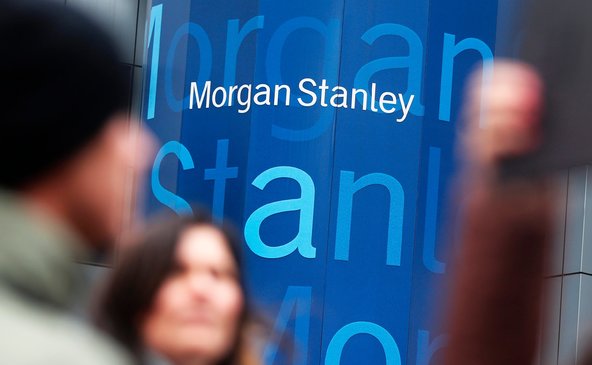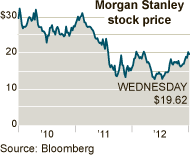 Shannon Stapleton/ReutersMorgan Stanley‘s headquarters in Manhattan. The bank plans to cut 6 percent of its institutional securities unit staff.
Shannon Stapleton/ReutersMorgan Stanley‘s headquarters in Manhattan. The bank plans to cut 6 percent of its institutional securities unit staff.
When Morgan Stanley’s top executives gathered in mid-September at the Gramercy Park Hotel in Manhattan to discuss strategy, some participants complained that the room was too small.
Apparently, that was the point: James P. Gorman, Morgan Stanley’s chief executive, chose the cramped quarters to force discussion among the executives, said people briefed on his decision but not authorized to speak on the record.

These days, it is the Wall Street firm that is finding itself a bit boxed in.
Regulatory demands, weak markets and lower credit ratings have weighed on all banks, but perhaps more so on Morgan Stanley, the smallest of the big Wall Street firms. In the three years that Mr. Gorman, 54, has been at the helm, the bank has been progressively shrinking its business of trading bonds, commodities and other investments and expanding into wealth management.
Now the storied company — whose take-no-prisoners trading desks have at times been rivaled only by firms like Goldman Sachs — is cutting even deeper, raising questions among some on Wall Street about whether it should spin off or ditch much of its trading business as its Swiss rival UBS has, a suggestion the firm eschews.
Morgan Stanley is planning another deep round of cuts: 1,600 jobs, accounting for 6 percent of its support work force, and, more telling, 6 percent of institutional securities, which includes its once vaunted trading business.
The planned cuts come just a week ahead of the release of fourth-quarter earnings, which are expected to show the gains the firm has made since the financial crisis in areas like stock trading, banking and wealth management but still will be weighed down by the diminished earnings power of its fixed income business.
Whether the company can avoid shrinking further — and a number of analysts say that additional cuts will be needed — and revive the fixed-income trading business will have significant ripple effects in the financial world.
While the strategy of cutting in some places and building out wealth management may lead to a more stable company, the retreat also means that the fixed-income trading business over all is becoming increasingly dominated by two Wall Street banks — JPMorgan Chase and Goldman — as well as by hedge funds and other investment firms that are more lightly regulated than banks like Morgan Stanley.
Before the financial crisis, the fixed income division at Morgan Stanley, which was created by J. P. Morgan partners when Depression-era laws forced them to split banking from trading, was one of the firm’s biggest moneymakers. Now, it is a drain on operations, producing just 20 percent of its revenue but tying up roughly half of its capital.
In recent years, the fixed-income department has not been able to make enough money to cover the cost to Morgan Stanley of this capital, according to people briefed on the matter but not authorized to speak on the record.
The fallout can be seen in compensation: a year ago, 110 of the roughly 500 managing directors in sales and trading did not get a bonus, and that number is expected to grow next week when bonuses are handed out.
Still, Mr. Gorman has received high marks from some on Wall Street for playing a difficult hand in the wake of the financial crisis. On Wednesday, he received a big vote of confidence when Daniel S. Loeb’s hedge fund told investors that it was taking a stake, saying that Morgan Stanley was “in the early innings of a turnaround.”
Still, hobbled by the new realities on Wall Street, that turnaround has so far proved to be a Sisyphean task.
The stock, said the shareholder Christopher Grisanti, has “languished.” Mr. Grisanti is the owner and co-founder of Grisanti Capital Management, which owns 690,000 shares of Morgan Stanley, valued at $13.5 million.
While the stock has risen since Mr. Grisanti bought it, it is down almost 40 percent since Mr. Gorman took over in January 2010, and big shareholders like the Bank of Tokyo-Mitsubishi UFJ of Japan, which holds a 22 percent stake valued at $8.5 billion, have had little in the way of returns. Morgan Stanley’s return on equity, Wall Street’s main benchmark of profitability, is 6 percent, down from 23.8 percent in 2006.
Morgan Stanley’s board, said people briefed on the matter, has discussed closing its fixed-income department. Instead, the firm is shrinking the unit, arguing that it is important to offer its customers those trading services. By cutting jobs and costs and exiting lines like structured products and other complex financial investments and focusing on less risky, less capital-intensive businesses like the trading of interest rates, executives contended that the division can generate a healthy return.
“We are not going to pull a UBS,” the senior executive Colm Kelleher told a private dinner of Morgan Stanley shareholders at Oceana restaurant in Midtown Manhattan.
A Morgan Stanley spokesman, Wesley McDade, said the firm was optimistic about its prospects.
“In 2013, we expect to benefit from the many strategic decisions we have taken, including an aggressive move into wealth management, a further strengthening of our pre-eminent equities and investment banking franchises, and the repositioning of our fixed income business to meet the realities of the new world,” he said.
Morgan Stanley wants to achieve a return on equity of 10 percent in the near term, and it is making progress as it continues to shed both employees and risky assets. Longer term, Morgan Stanley is shooting for a return on equity in the middle teens, according to people briefed on the matter but not authorized to speak on the record.
Critics said Morgan Stanley executives initially moved too slowly to cut business lines, and set unrealistic revenue goals for the division that were never met.
Recently, Mr. Gorman tapped one of his bankers, John Pruzan, to be his eyes and ears in meetings about the revamping of the department. Even that move was not without controversy, though. Some executives in that department, including the fixed income chief Kenneth deRegt, felt it added an unnecessary layer of management.
At the same time, while trying to squeeze risk out, it has taken some surprising ones, hiring for instance a powerful and controversial trader to run its rates desk, a primary center of growth for the fixed-income department. That trader, Glenn Hadden, is under investigation by a key regulator for his trading in Treasury futures. In 2009, he was put on leave at Goldman because of a separate trading incident.
Through Mr. McDade, the Morgan Stanley spokesman, Mr. Hadden declined to comment. A lawyer for Mr. Hadden also declined to comment, but has said that his client did not engage in manipulative activity.
The firm Mr. Gorman runs bears little resemblance to the one that existed before the financial crisis. Mr. Gorman’s predecessor, John J. Mack, pushed risk-taking, leading to a $9 billion loss in 2007, one of the largest single trading losses in history, as well as billions of dollars in additional losses because of exposure to bond insurers.
These events nearly crippled the firm, and Morgan Stanley was forced to sell a piece of itself to Mitsubishi, which injected $9 billion into the firm. Not long after, in January 2009, Morgan Stanley made another important strategic investment, combining its wealth management operations with Citigroup in a joint venture that gave Morgan Stanley control.
Still, just weeks after taking over as chief, Mr. Gorman took the stage at a Hilton in Midtown Manhattan on a cold winter day to assure a standing-room-only crowd of investors that maintaining the firm’s position as one of Wall Street’s most powerful investment banks was a top priority for him.
Even in early 2010, however, it was clear to many inside the firm that he would have his work cut out for him.
Every Wednesday, executives from various corners of the bank who belonged to what was known as the asset liability committee would meet at noon to examine the cost to the firm of everything from looming credit-rating downgrades to regulatory changes.
“It was the most depressing meeting ever,” said one attendee who spoke on the condition of anonymity. “It was very clear the Morgan Stanley we knew was never coming back.”
Article source: http://dealbook.nytimes.com/2013/01/09/deep-cuts-raise-questions-about-morgan-stanley/?partner=rss&emc=rss
Speak Your Mind
You must be logged in to post a comment.